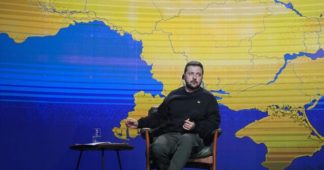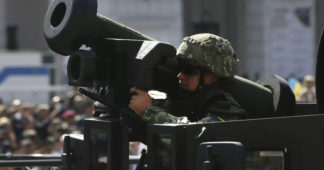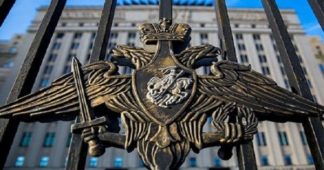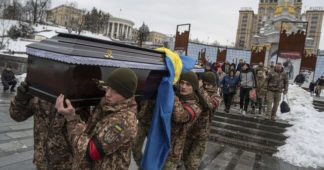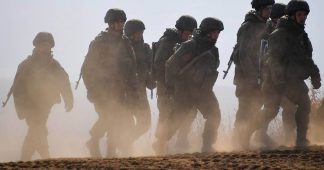By Dmitri Kovalevich
Jan 17, 2024*
The beginning of the New Year in Ukraine is shrouded in much gloom, with a noticeable accumulation of irritation in society. Social events during the holiday period were held behind tightly closed doors, with blackout curtains and guards at entranceways. Fireworks were already banned in the country and this year it was rare to see a flashing Christmas tree in a house window or shopping district.
Christmas celebrations were changed this year because in their anti-Russia zeal, Ukraine’s leaders have officially changed the date of Christmas from January 7 to December 25. For centuries, January 7 marked the day of celebration of Christmas for Eastern Christian churches, including the Russian Orthodox Church, the largest denomination in Ukraine.
Men across Ukraine are facing intensified military conscription as the new year opens, with mobile police and military checkpoints operating in and between city districts. Often, men of military age are simply seized on the street by police or military recruiters and soon find themselves at the military front following the briefest of training.
On January 4, the Ukraine Rada (legislature) held its first formal discussion of proposed revisions and tightening of the military conscription law. Among the proposed revisions is the lowering of the conscription age from 26 in order to capture, as it were, men otherwise planning on higher education. Some far-reaching proposals being aired include confiscation of the property of conscription evaders (‘draft dodgers’ in American slang) and revocation of the passports of those who have left the country. (Ukrainian men of military age are forbidden from leaving the country except by special permit.)
Possible timeline for the end of the conflict
Ukrainian and Western experts are asking themselves at the beginning of 2024 how long the conflict with Russia may last and what to expect from the coming year. One analyst in Japan believes the war may last another five years, while many in the U.S. say that the outcome of U.S. elections ten months from now will be the decisive factor.
Russian security expert and reserve FSB (security service) officer Sergei Khrapach writes on Telegram that the continuation of the armed conflict in Ukraine would be the result of unresolved conflicts between Russia and the United States. He says the U.S. is firmly opposed to ceding its self-appointed role of “world gendarme” because this would open the door to a multipolar world order, a very bad thing in its eyes. Consequently, Russia’s special military operation in Ukraine will only end when the conflicts in the region between the two major powers are resolved.
Other Russian analysts are convinced that the military operation may last through 2024, noting that Russia’s military industries are only just reaching optimal production capacity.
Ukrainian generals have nowhere to lead their soldiers
Ukraine President Volodymyr Zelensky spoke to German media in late December about the challenge facing government’s declared goal of mobilizing some 500,000 additional Ukrainians into its armed forces. Quite aside from the challenging task of tracking down the 500,000, then forcing many of them into training and eventual service, Zelensky explained that some 500 billion hryvnias (US$13 billion) are needed from the state budget to pay for training, equipment, and salaries.
“One fighter requires six people [to keep him or her active and under arms]. That’s six people in civilian life working and paying taxes. Multiply the 500,000 additional military recruits we need times the six civilians needed to support each one of those. How can I, the government, pay for three million additional personnel beginning this month, January 2024?” Zelensky asked in his commentary.
The German report added, “According to calculations by Vladimir Dubrovsky, a senior economist at the public organization CASE-Ukraine, which specializes in macroeconomic policy research, about 170 billion hryvnia per year (US$5 billion) are needed just for the salaries of those who are mobilized into the armed forces. ‘If you take the average salary of 30,000 hryvnia per month ($US800), this comes out to 360,000 per person per year, for a total of 170 billion hryvnia per year. And that is not to speak of the costs of arms, food, clothing, and other equipment.’ ”
The head of the Armed Forces of Ukraine, General Valery Zaluzhny, spoke to the aforementioned Rada session on January 4 and he stressed the need to boost military recruitment. One observer reported Zaluzhny asking the legislators, “With whom and what am I supposed to fight? Either you turn to the world asking for fighters, or go join the fight yourselves.” Zaluzhny promised 80 full days of training for new recruits, likely responding to the widespread belief in Ukraine (and claims by soldiers themselves) that recruits are not given adequate training before facing the hellfire of the frontlines. “Give me more people,” he urged lawmakers.
Former Interior Minister and prosecutor-general of Ukraine, Yuriy Lutsenko, said in early January that Ukraine was losing an average of some 30,000 military personnel on the frontlines per month to death or injury. In Lutsenko’s opinion, the total losses since the beginning of the conflict amount to half a million people – the exact number of replacements that the Kiev regime is calling for today.
Dying for the sake of Western interests
Soldiers in Ukraine’s Marines service recounted to the Washington Post recently that they are being “tossed like pieces of meat to the wolves” along the front lines of the conflict. They describe the very harsh efforts ordered by their superiors in December to reclaim some slivers of territory lost in the Kherson region last year on the opposite side of the Dnieper River. “We bear many losses. We simply lose people, but there is no result”, says a 22-year-old marine named Dmytro.
Describing the operation in Kherson, the WashPo writes, “With their counteroffensive stalled, Ukraine’s military and political leaders were eager to show their Western backers some progress — any progress.” It recounts stories from the marines of wounded soldiers drowning in the marshy conditions on the east side (‘Right Bank’) of the Dnieper River, unable to swim with their injuries or being sucked into the waters by their heavy packs.
To limit or prevent Ukrainian politicians from telling Western publications anything that contradicts Zelensky’s official positions, the elected members of the Rada are now, of January 1, prevented from travelling abroad unless under instruction from the Ukrainian Foreign Ministry, as explained recently on Telegram by Ukrainian MP Yaroslav Zheleznyak.
As stated in the document published by the MP, a trip can be denied if, during a previous foreign trip, the MP did not receive “official explanations from the Foreign Ministry regarding Ukraine’s foreign policy course” or did not fairly report same. To put matters simply and crudely, in a country, Ukraine, which the West claims to be a democracy, elected leaders may now only make comments or statements on government policy that have been approved by the Ukrainian president or the government he leads.
Brutal, class war in Ukraine for prosperity in the United States
Ukrainian Foreign Minister Dmytro Kuleba is confident that the United States will not abandon Ukraine, as it abandoned Afghanistan in 2021, because Ukrainians are fighting precisely for U.S. prosperity. “We don’t have a plan B. We are confident in plan A,” Kuleba said when asked what Kiev would do in case of a shortage of military aid from the U.S. or other NATO countries.
Kuleba is confident that the aid will not stop because it is “an investment in defense of NATO and also in defense of the prosperity of the American people”. In other words, the 30,000 people being killed or seriously injured each month on the Ukraine side are an investment in the prosperity of the United States, not of Ukraine. Indeed, under the current circumstances, Ukraine is running the risk of further, serious depopulation. There has been no census conducted in Ukraine since 2001, a situation resembling Sudan and or Somalia, two countries which the UN has been urging for decades to conduct a census in their respective countries.
Ukraine’s population 30-plus years ago, at the time of the demise of the Soviet Ukraine, was 52 million. By 2001, following the dismantling of the planned, social economy of Soviet times and a resulting, sharp social and economic decline, the population had shrunk to 48 million. Estimations following that differ.
A report by the Kyiv School of Economics in August 2023 says the population was 37 million in 2021 and it estimates this number to fall to 30 million by 2030. Ukraine’s Institute for the Future (UIF) estimates the population in 2023 at 28.5 million.
All of this is understood in the United States. Recently, U.S. Army Colonel Douglas McGregor, a former advisor to President Donald Trump and a conservative critic of the current war, tweeted: “We have set the Ukrainians an impossible mission and basically told them to die there. I think the Ukrainian people have had enough … At some point we will see what happened in Afghanistan happen in Kiev.”
By requiring more and more Ukrainians to submit to conscription, the Ukrainian authorities have once again emphasized the class-based nature of the measure. Previously, wealthy Ukrainians could pay off the conscriptors and go abroad. But with the proposed changes to the law, Ukrainian MPs are actually discussing how to protect people of privilege from conscription. This recalls past centuries in which only men of property could vote. The KP.ua news website reports that Ukrainians in social networks are taking note that the very principle of equality of citizens is at stake and social tensions are on the rise as a result.
Different missile strike strategies
In late December and early January, Ukraine and Russia exchanged a series of missile strikes. The Russian Federation military fired more than 120 missiles as well as dozens of attack drones each day against Ukrainian military enterprises and military facilities. That the Russian weapons targeted military operations (storage, supply, transport) is recognized even by Ukrainian experts. Ukraine could only mount responses of five or six missiles per day.
Since 2022, the Ukrainian public has been assured by authorities that the Russian Federation has only a limited supply of missiles and artillery, sometimes only enough to last for a few days at a time. The public was told that Russia’s weapons supplies would not be easily replenished. This claim and variants thereof have been constantly repeated ever since. The pro-Western ‘Bellingcat‘ internet outlet joined that same chorus early on, with spokesman Hristo Grozev saying in March 2022 that the Russian military campaign would collapse within days.
In essence, Western and Ukrainian politicians are applying to the Ukrainian people the manipulative methods commonly applied by parents or psychologists to children who resist an unpleasant procedure or task, that is, to plead for patience, then more patience, and yet more patience with the promise that everything will soon be better. These methods are being applied to the Ukrainian population as a whole in refusing to countenance peace negotiations with Russia.
It is also noteworthy that there remains a big difference between the Russian Federation and Ukraine in their respective uses of missiles and artillery. The Russian Federation is pursuing a declared strategy of the demilitarization of Ukraine, and so it strikes warehouses stocked with Western-supplied weapons, weapons-producing or -repairing facilities, and military transport. It strictly avoids any strikes against civilian targets, and even some politicians and ultra-nationalists in Ukraine acknowledge this.
For its part, Ukraine weaponry cannot reach most Russian factories and warehouses, so it employs terrorist tactics against the Russian population by striking civilian targets in towns and cities. Valeriy Zaluzhny, the AFU commander-in-chief, is reported by the Ukrainian news publication Strana as stating that the Russian people are not presently against the war in Ukraine because they do not fully experience it “in every sense”. Ukraine’s strategy is “to make these feelings more acute for the Russians, despite the considerable distance to targets.”
Such thinking is also being justified in Western publications. “Ukraine trains its sights on the Russian border region, seeking to stir up discontent”, headlines a January 3 report by Associated Press. It writes approvingly: “Hitting [the Russian border city of] Belgorod and disrupting city life is a dramatic way for Ukraine to show it can strike back against Russia, whose military outnumbers and outguns Kyiv’s forces. The tactic appeared to be having some success, with signs that the attacks are unsettling the [Russian] public, political leaders and military observers.”
In general, even Ukrainian military officers on Ukrainian television say that the Russian army is better equipped than the Ukrainian army. In early January, an AFU battalion commander of the third assault brigade with the call sign ‘Rollo’ explained as much. Responding to a viewer of broadcast panel discussion who asked what kind of equipment the average Russian military has and “how much worse is [their equipment] compared to ours?”, the commander replied: “The Russian army is no worse than the Ukrainian army, even better. Technologically better equipped, has more vehicles, better weapons, better equipment than the Ukrainian one.” According to him, the Russians not only have better equipment but also better programs to train and equip its army.
The Russian Defense Ministry is reporting that 54 foreign countries are providing military assistance to Ukraine and have already spent more than 200 billion dollars since the start of the special operation. It is obvious that all Western countries, as well as Japan and South Korea, are helping Ukraine with money and weapons and that these same, leading capitalist countries are using Ukraine to protect their hegemony over the rest of the world and keep the existing world order in place.
Between the desire for socialism and the cult of Nazi-collaborationists
There are also large differences in moral standing between the Ukrainian and Russian armed forces. While the Ukrainian authorities claim almost every day in their statements to the West that they are fighting for the United States, for NATO and for Europe, those on the Russian side appeal to the Soviet legacy of fighting Nazism and big-power domination. These sentiments on the Russian side are sharply intensifying. In late 2023, Russian sociologist Maria Matskevich of the Institute of Sociology of the Russian Academy of Sciences, wrote a report in the printed magazine Polity, issue #4 in 2023. She cites stunning data, according to the Russian blogger ‘Tolkovatel’: “Thus, in 2022-2023, the desire to live in a socialist rather than capitalist society has risen sharply [in Russia]. While in 2020, sympathies for socialism and capitalism were about equal (26% and 21%, respectively), by mid-2022, 48% chose socialism and only 12% capitalism. In 2023, this ratio is already 48% vs. 5%.”
By contrast, in Ukraine there are constant appeals by the government and its supporters to the legacy of the Nazi collaborators of the World War II era of the Organization of Ukrainian Nationalists/Ukrainian Insurgent Army. However, such appeals unwittingly generate defeatist sentiments and increase the desire of many Ukrainians to flee to the West. In early January, the commander of the ‘Aidar’ company (a neo-Nazi battalion accused by Amnesty International back in 2014 of war crimes against the people of Donbass) named Yevhen Dikiy mentioned in an interview by Strana that in case of defeat, armed Ukrainian units “can break through the [western] border of Ukraine in an organized manner, enter the European Union and live there.” He cited the experiences of many Nazi-collaborationists from WWII Ukraine the UIA who did succeed in entering American and British zones of occupation in Germany and gaining refuge and protection.
Ukraine without land and without people
On January 1, Ukraine launched the second stage of a land reform that has been long demanded by the International Monetary Fund and other Western creditors as a condition for financial assistance to the country. Beginning in 2024, legal entities [companies] can buy agricultural land. Previously, only individuals could do so. As well, the size of a plot that can be purchased has risen to 10,000 hectares (100 square kilometers).
“Ukrainian farmers will return from the front only to find that the country has run out of land for them,” warns the Ukrainian Telegram channel ‘Minister of retirement’. It warns that as a consequence, as occurred 100-plus years ago, farmers along the front lines may “stick their bayonets into the ground” and return home to fight for their land.
In Ukraine, most agricultural land has been bought up by Western agricultural holdings through frontmen, as the Oakland Institute explains in its research report issued in early 2023, titled ‘War and Theft: The takeover of Ukraine’s agricultural land’. Now such land acquisition can be done openly and legally. In early January, major American billionaire Warren Buffett announced that he plans to build logistics hubs in Ukraine’s Transcarpathia region for grain transshipments. Thus we see that farmers in Europe’s poorest country, Ukraine, have no money to buy the land that until recently they managed and owned collectively or individually, as inherited from Soviet Ukraine and the USSR. Ukrainians are now dying in a war for control of land whose ownership is being bought up by large agricultural interests in the West.
In general, the continuation of the conflict in Ukraine driven by the interests of foreign (Western) capital threatens to leave the country not only without a viable population but also without land for its people to work and with which to prosper.
* Dmitri Kovalevich is the special correspondent in Ukraine for Al Mayadeen English. He writes a monthly situation report as well as occasional special reports such as the following.
We remind our readers that publication of articles on our site does not mean that we agree with what is written. Our policy is to publish anything which we consider of interest, so as to assist our readers in forming their opinions. Sometimes we even publish articles with which we totally disagree, since we believe it is important for our readers to be informed on as wide a spectrum of views as possible.
